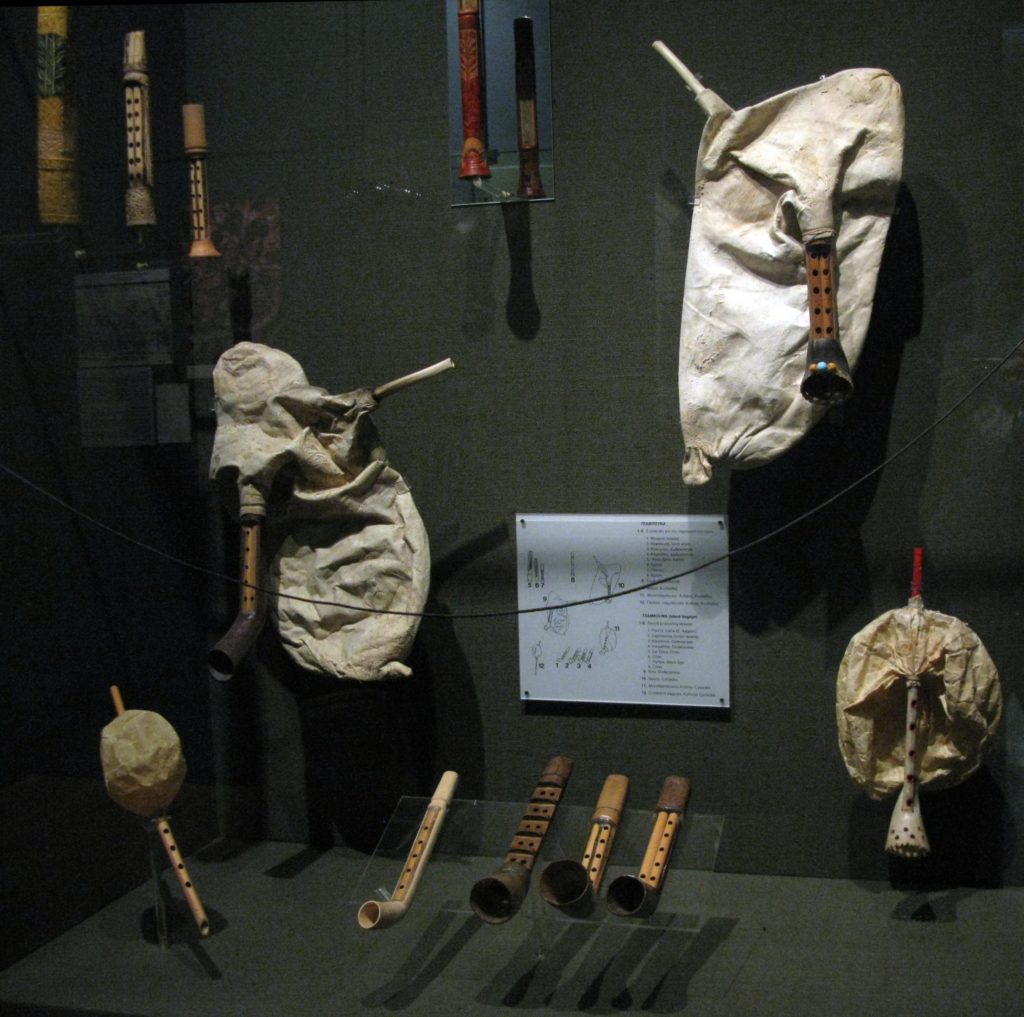
The Mykonos bagpipe called tsabouna, which has been played for centuries, recently lost one of its musical maestros. In early May 2021, 90-year-old Dimitri Koukas, “Mitsaras,” passed, taking with him a lifetime of Mykonian musical memory.

In the small, almost clandestine gatherings, where the old musical practices are still preserved, the tsabouna expresses the quintessence of the community’s collective identity.
The tsabouna is a Greek folk wind instrument of the bagpipe family. The pipes are not blown into directly from the musician’s mouth but via an air reservoir. It has been used for centuries in the traditional music of the Aegean islands.
The tsabouna’s traditional repertoire consists of the folk dances particular to each island, local songs, and music for folk ceremonies. A bagpipe is sounded by reeds to which wind is fed by arm pressure on a flexible bag. This bag is kept filled with air from the mouth or from small bellows strapped on the waist and to the other arm.
The tsabouna, usually in concert with the toubaki, a handcrafted drum, is played today at small family pig slaughtering festivals, (Xirosfagia), weddings, baptisms, and at celebrations of saint’s names days in family-owned chapels (Panigiria) all across Mykonos.
Koukas, a lifelong resident of Mykonos, was raised as a farmer and eventually became a construction contractor as the island began to grow into a destination for tourism and development boomed.
As a youngster, he first expressed interest in the tsabouna thanks to a family tradition of tsambouna and toubaki players on the rocky isle.
Television Show Features Mykonos Tsabouna
In 2017, his traditional folk music was recorded on the show Alati Tis Gis (Salt of the Earth), broadcast on the Greek Public Television network, ET. Alati Tis Gis features as its staple of programming traditional Greek music.
When the show’s host, Lambros Liavas, learned of Koukas’ demise, he made the following statement on the television program’s Facebook page: “Dimitris Koukas, affectionately known to us as “Mitsara,” lived his days full of festivity for his 90 years. He was a regular presence when his fellow musicians, Babelis and Kantenasios, would gather to preserve Mykonian tradition.”
They were the valuable music ambassadors from another Mykonos, hidden behind a contemporary façade, adds Liavas.
Continuing in tribute, Liavas writes, “I was always fascinated by “Mitsaras” with his stuttering voice and the unique passion that blew the instrument, transfusing his breath and soul, together with the… alcohol from his glass!”
“You either fall in love with the tsambouna,” writes Liavas, “or you can’t stand it for a minute…there is no in-between,” according to the television host. “But in order to love the tsampouna, you must also reach ecstasy, indulging in her primordial rough sound,” he adds.
The old tsambouna players were never professional musicians but remained ordinary farmers, shepherds, fishermen, people who toiled in nature and were magnanimous, states Liavas. “Mitsaras was exuberant, generous, and humorous,” he writes, adding that he “[feels] lucky to have met him and to have claimed a place in his company.”
The echo of Mitsaras’ tsambouna and song will continue to give energy and inspiration to the new generation that takes up the musical the baton in the future, Liavas writes.
Songs and dances are not mere entertainment: they are vehicles of common memory and group cohesion. They are a dialogue between present and past and between the individual and the group. In these contexts, a bagpiper in Mykonos will never be seen performing on stage nor will a singer sing into a microphone be seen.
The duration and lyrics of every song are determined by the group during performance. Generations-old tunes are rendered each time in a unique, unprecedented and unrepeatable way. There is no standardization. Not only do the musicians themselves improvise but the participants do, as well.
Tsabouna’s history in Mykonos
The tsabouna in its current form is not mentioned in sources older than the 15th century. Perhaps no authors found any interest in information about village festivities. The precise origins of this particular type of this instrument are unknown.
Every member of the bagpipe family, the tsabouna included, has a bag and one or more pipes. Pipes can vary as much as simple bagless wind instruments, and each of them has its own history. Some existed before the invention of the bag and were then combined with it while others first appeared in the form of a bagpipe.
There is no recorded history of the Mykonos bagpipe as such. Its pipes belong to one of the oldest types of wind instruments, documented several millennia ago in the great civilizations of antiquity (Mesopotamia, Egypt, and later Greece). The bag’s first appearance in Greece dates from the Roman period, and it is believed to have been imported from the East.
Construction of the Tsabouna
The Mykonos bagpipe has two short cane chanters of equal length placed in parallel position so they can be played as one and tuned in unison. Fingerholes may be the same on both chanters. The two chanters are fastened into a wooden or cane yoke ending in a bell and usually made of cow horn. Fastened to the upper end of the chanters and hidden inside the bag are two single-blade reeds.
The bag has two openings. One holds the mouthpiece, the blowpipe, and the other the yoke. The air travels from the player’s mouth to the bag through the mouthpiece and then passes through the reeds’ blades causing them to vibrate and thus to sound.
The Mykonos tsabouna is made entirely of natural materials with the least possible processing. The bag is the skin of a whole goat, the chanters are of natural cane, the blowpipe is a bone or another piece of cane, and the bell is from an entire cow horn. Beeswax is used as a glue and natural fibers or leather strips for bindings.
Tuning is adjusted with a hair or thread in the reed or with a straw inside the bore of the pipes. Tsabounas are traditionally constructed not by specialized instrument makers but by the players themselves. Construction, much like playing, is learned empirically with no theory or any organized learning system.
The secrets of this art, varying from island to island, are orally transmitted or copied. All the materials and tools needed for construction are to be readily found in the piper’s immediate environment either in nature or in the traditional household.
Tsabounas are played on most or at least some of the islands of the Cyclades, Dodecanese, and the Northern Aegean, as well as an in Crete. In each of these areas, the local tsabouna has some peculiarities so that every island has its own unique variant of the instrument. It is also currently played by a handful of musicians residing in Athens without origins from any of the previously mentioned islands.
Not every bagpipe is a tsabouna. A great variety of bag instruments that differ from the tsabouna are played throughout Europe, from the British Isles and Spain to the Balkans. One of them is the Greek gaida, played by the local population of Macedonia and Thrace.
A revival for the Mykonos Tsabouna?
In the 21st century, interest in the Mykonos tsabouna has been growing and re-oriented. Although its tradition emerged out of a now obsolete social context, current reality is giving birth to a new tradition.
New musicians, a new audience and other new trends, such as terms of listening, novel repertoires, and most importantly, timeless messages, form the framework within which an older instrument remains alive and even gains popularity.
This new tradition co-exists alongside the old one by which it is also inspired. It breaks the previously close bond with local communities, transforming the tsabouna music from a set of local dialects into globally common language.
See all the latest news from Greece and the world at Greekreporter.com. Contact our newsroom to report an update or send your story, photos and videos. Follow GR on Google News and subscribe here to our daily email!



